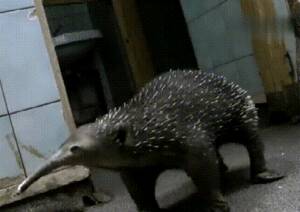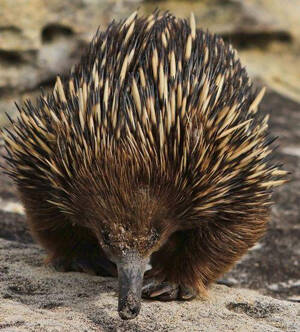Tachyglossus aculeatus
IUCN
LCBasic Information
Scientific classification
- name:Tachyglossus aculeatus
- Scientific Name:Tachyglossus aculeatus
- Outline:Monotremata
- Family:Echidna genus
Vital signs
- length:35-50cm
- Weight:About 6kg
- lifetime:About 50 years
Feature
It is the most widely distributed and common monotreme in existence
Distribution and Habitat
Distribution area for the Australian New Area, mainly living in Australia, Tasmania and other places in the forest.
Appearance
The body is 0.5 meters long and weighs about 6 kilograms. It has spines all over its body and five fingers with strong claws. The nostrils and mouth are located at the rostral end; Small mouth, toothless, slender tongue; Small eyes; Outer ear shell, partially hidden in hair; Short limbs, all 5-toed; Poisonous distance of ankle of hind limb of male; Short tail, bare underside.
Details
The Australian echidna Tachyglossus aculeatus is adapted to an ant-eating lifestyle and lives in rocky, sandy and scrub areas, living in crevasses and self-dug burrows. Come out at dusk and night. Powerful claws for digging. Usually on the ground activities, encounter danger, can quickly dig into the ground, in an emergency will also roll into a thorn ball to protect themselves. Although they have some vision, they mainly rely on hearing and smell. In search of food, kiss forward, lifting the ground cover as you explore. The main food is ants and termites, which are caught with thin, mucous tongues and ground with a horny plate on the tongue and a stiff ridge at the top of the mouth.

The breeding habit of the Australian ecmole is very special. The female animal lays an egg with a leathery shell (about 1.4 to 1.7 cm in length and 1.3 to 1.5 cm in diameter) directly through the genital pore into the pouch, and about 10 days later, an immature young breaks out of the shell with a body length of about 12 mm and a weight of less than 0.5 grams. It lived on breast milk in the bag for about 2 months, grew thorns and was born a second time from the bag, but it was not yet able to live independently, and when the mother animal went out to search for food, it was placed in a safe place. During hibernation, the body temperature can drop close to the ambient temperature.
Listed on the International Union for Conservation of Nature (IUCN) 2015 Red List of Threatened Species ver 3.1 - Not Threatened (LC).
Protect wild animals and eliminate wild meat.
Maintaining ecological balance is everyone's responsibility!







